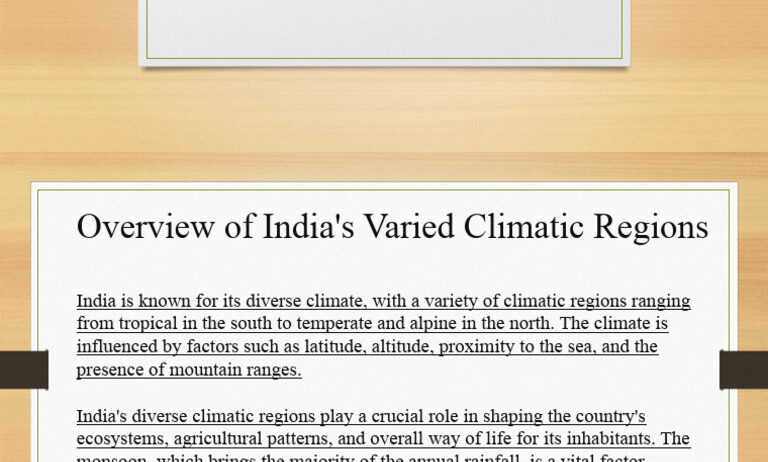India, a country synonymous with diversity, presents a multifaceted climate that can deeply influence its ecology, agriculture, and the daily lives of its inhabitants. Understanding India’s climate helps in grasping the broader picture of global climate change, which disproportionately impacts developing nations. The subcontinent operates under a variety of weather patterns that range from the torrid heat of summer to the chilly embrace of the Himalayan winters. This article explores the intricacies of India’s climate, delving into regional variations, seasonal characteristics, and the effects of climate change.
The Indian climate can be broadly classified into four distinct seasons: winter, summer, monsoon, and post-monsoon. Each season possesses unique characteristics that not only shape the environment but also dictate agricultural practices, water resource management, and even cultural festivals. Observing these seasons offers profound insights into how communities adapt to their climatic realities.
Winter (December to February)
The winter months in India, typically spanning from December to February, offer a respite from the sweltering heat of the summer. Northern regions, particularly those in proximity to the Himalayas, experience a significant drop in temperature, often plummeting to single digits. This cold spell is particularly pronounced in states like Jammu & Kashmir, Himachal Pradesh, and Uttarakhand, where snow-capped peaks emerge like alabaster giants against the backdrop of a clear blue sky.
In contrast, southern regions, such as Tamil Nadu and Kerala, remain relatively mild, with temperatures in the range of 25-30 degrees Celsius. The winter months are crucial for the rabi crop cycle, where farmers plant wheat, barley, and other crops, taking advantage of the cooler, dryer conditions.
Summer (March to June)
Following winter, the summer months—from March to June—establish their dominion over the Indian subcontinent with unrelenting temperatures. The sun blazes across the vast expanse, leading to extreme heat, particularly in the interior of the country. States like Rajasthan and Gujarat can record temperatures soaring above 45 degrees Celsius, creating a sweltering climate. Heatwaves frequently enhance the discomfort, challenging both human endurance and natural ecosystems.
This period is not merely a test of resilience but holds significance for agriculture as well. Farmers engage in the kharif planting season, sowing crops that thrive in the monsoon rains. Additionally, the sweltering heat significantly impacts water availability. Reservoirs diminish and rivers shrink, creating mounting pressure on water resources already strained by population growth.
Monsoon (June to September)
Arguably the most critical season in India, the monsoon manifests as a transformative weather pattern that brings life-giving rain and rejuvenation to the parched landscapes. Beginning in June, the southwest monsoon arrives, driven by the Indian Ocean’s moisture-laden winds. Regions like Kerala witness the first showers, symbolizing hope and abundance. As the season progresses, the rains sweep in from the west to cover vast areas of the country, often causing a renaissance of agricultural activity.
Yet, with its bountiful blessings comes peril. The monsoon season has a dual nature; excessive rainfall can result in flooding, devastating crops and communities. Arkansas witness heavy downpours that lead to rivers overflowing, while others experience delayed rains that disrupt agricultural cycles. Understanding this delicate balance is pivotal for farmers and policymakers alike.
Post-Monsoon (October to November)
As the monsoon recedes, India enters the post-monsoon period characterized by a return to slightly cooler temperatures and clearer skies. This season, particularly evident in October and November, marks a transitional phase where farmers harvest their kharif crops and prepare for the ensuing rabi season. The skies clear dramatically, offering a stark contrast to the tempestuous rains that preceded it.
This time also heralds a myriad of festivals across India, where communities celebrate the harvest and the onset of winter. However, the post-monsoon period is not devoid of challenges. Factors such as air quality and pollution can become significant issues, particularly in urban centers like Delhi, where the onset of winter exacerbates smog formation.
Regional Variations in Climate
India’s vast expanse means its climate is not uniform. The Himalayan region experiences a cold alpine climate, whereas coastal areas like Goa and Mumbai enjoy a tropical maritime climate characterized by high humidity levels. The Thar Desert presents a starkly different condition, with arid temperatures and minimal rainfall. Meanwhile, the northeastern states exhibit a subtropical climate, with some areas receiving the highest annual rainfall in the world.
These regional variations shape not just agricultural patterns but also the socio-economic fabric of communities. Understanding local climatic conditions is imperative for sustainable development, ensuring food security, and leveraging natural resources in harmony with the environment.
The Impact of Climate Change
India stands on the frontlines of climate change, facing vulnerabilities associated with rising temperatures, erratic rainfall, and extreme weather events. With a populace that relies heavily on agriculture and natural resources for sustenance, the ramifications of a shifting climate raise pressing concerns. Crop failures, water scarcity, and the anticipated displacement of communities underscore the urgent need for adaptive strategies and resilient practices.
In conclusion, comprehending India’s climate extends beyond an academic exercise. It invites an appreciation of the interconnectedness between weather patterns, ecological health, and societal well-being. By fostering a deeper understanding of these dynamics, individuals and communities can engage meaningfully in efforts to combat the existential threat of climate change. The challenge ahead is formidable, but through conscious action and strategic planning, a sustainable future remains within reach.







